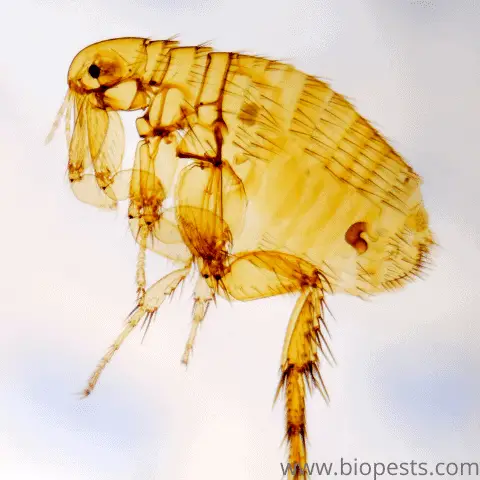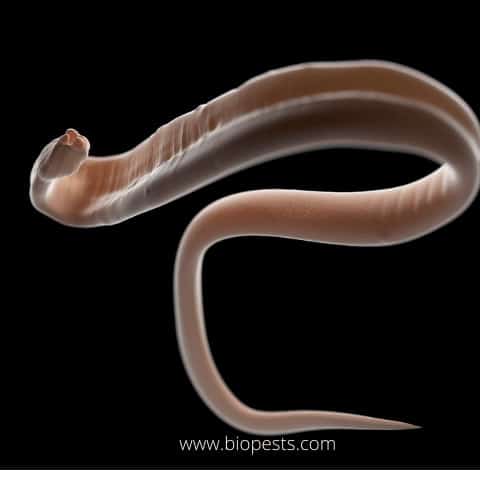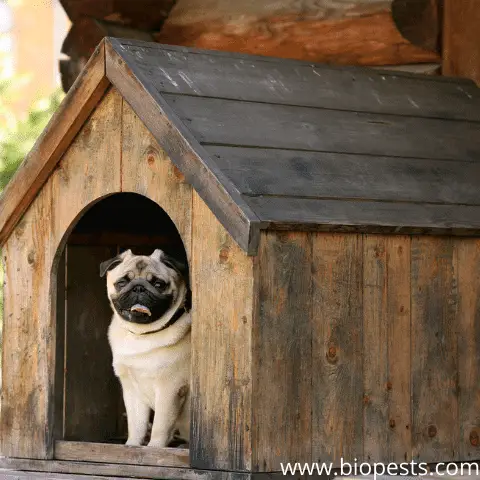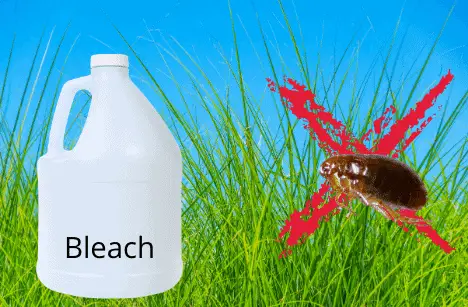Fleas are annoying pests that thrive in shady, moist, and grassy areas, so you might encounter them often if you have a garden. One of the most popular ways to get rid of fleas is to spray bleach in various parts of your home. Now, since this chemical is such an effective flea killer, should you use it to get rid of fleas in your garden as well?
Bleach will kill fleas and their eggs in the yard. However, it’s not advisable to use undiluted bleach as a flea killer in gardens as it can also harm plants, flowers, and crops. Plus, soil drenched in bleach no longer contains sufficient nutrients to support plant growth.

Are you struggling with a flea infestation in your home garden? In this article, we’ll further explain why you should keep bleach away from your plants, where to find fleas in your garden, and how to kill fleas without using harmful chemicals.
Why It Is Not a Good Idea To Spray the Yard With Bleach
Admittedly, bleach is an effective flea killer. Not only does it eliminate adult fleas, but it also prevents pest proliferation by killing the eggs before they even hatch.
On top of that, bleach naturally repels fleas. Even if a few pests do sneak past your flea traps, they will die instantly the moment they start crawling on bleach-soaked surfaces.
Sadly, bleach is also a plant killer. The main reason you can’t use bleach on your home is it contains the chemical chlorine. Yes, it’s a naturally occurring element found in nature, but dumping buckets of chlorine-filled bleach on your garden will lead to negative results.
Now, exactly what would happen if you did use undiluted bleach on your garden? Firstly, small plants would die. The smaller a plant is, the lesser amount of chlorine is needed to kill it. Plants exposed to a lethal amount of chlorine would have a brown, wilting appearance—these signs would first appear on the leaves or flower buds.
Secondly, the soil would become unable to sustain plant growth. Some homeowners might assume that it’s okay to dump chlorine in their yard if they’re not growing plants and flowers.
This misconception is far from the truth. Excess chlorine drastically spikes soil pH levels, thus stripping away essential nutrients and minerals, such as magnesium, iron, and calcium. Afterward, you’ll no longer be able to grow plants in that specific plot of land.
Lastly, excess chlorine will hamper plant development. The amount of undiluted bleach needed to kill a plant varies on a case-by-case basis. That means larger plants may be able to survive.
Now, if we’re talking about a fully grown tree, it’s unlikely that pouring a half glass of bleach will deal any immediate, noticeable effects.
However, if you dump the same amount of bleach on a smaller tree or plant, it might stop growing. The plant may not die instantly, but you’ll likely see a difference in the size of its leaves, branches, and flowers.
The Potency of Bleach as a Plant Killer
Saying that bleach will kill your entire garden is an overestimation. Bleach can kill different plants and prevent them from growing. However, there are certain factors to consider as well. These include:
- Amount: The effects of pouring bleach on your garden heavily depends on how much you’re planning to use. A glass will likely kill one or two small plants. On the other hand, dumping two or three buckets of pure bleach on your lawn will cause serious long-term effects. At worst, you might not even be able to grow plants in your garden anymore.
- Dilution: Diluted bleach is unlikely to have much effect on your plants. Most of the negative short and long-term effects of chlorine toxicity would only appear if you used pure, undiluted bleach on your lawn.
- Frequency: Would it be safe to spray your lawn with small amounts of heavily diluted bleach? We wouldn’t advise it. At first, small amounts of diluted bleach may be too minuscule to do any real kind of damage. If you consistently expose your plants to the same small amount of bleach every day, however, you’ll then run the risk of chlorine toxicity.
Bottom Line: Overall, it’s not a good idea to use bleach as a flea killer in your garden. Some plants may survive at first. However, it won’t be long until your entire garden wilts if you decide to rely solely on bleach for your flea control needs.
What Is the Best Way To Kill Fleas in the Yard Organically?
You don’t have to pour bleach on your garden lawn just to control your flea infestation. There are multiple other ways to kill fleas organically. Some of which include the following:
Properly Dispose of Trash
Old furniture, scrap wood, and other trash attract all kinds of pests, not just fleas. So, if you’re the type to leave junk lying around the yard, now’s the best time to start cleaning up, regardless of whether you’re dealing with a flea infestation or not.
Prioritize this task above all. No matter how much insecticide you use, random critters, strays, insects, and pests will wander into your home if you do not make an effort to keep your yard clean and junk-free.
Trim the Lawn
Another simple, easy way to keep fleas out of your yard is to regularly trim the lawn. As we mentioned, fleas thrive in shady areas. If you forego lawn upkeep and let your grass grow tall and unkempt, your lawn’s bound to attract fleas, as well as many other pests.
Ideally, strive to mow the lawn every one to two weeks. You don’t necessarily have to whip out the lawnmower every single time, especially during months when the grass isn’t too quick to grow, but at least remember to trim them.
Drive Other Pests Away
How do fleas get into one’s home? Unlike other insects or animals, fleas do not wander into various new locations on their own.
Fleas need a host to survive. Without one, they won’t even be able to live for more than two weeks, much less travel long distances. Thus, if you want to get rid of fleas, focus on driving the other pests away as well.
Some animals and critters that might carry fleas into your home include:
- Deers: The best approach here is to scare off wandering deers. Try installing motion-activated sprinklers that’ll set off if a deer, or any stray critter, steps on your property. You can also have your big dogs scare off wild deers.
- Raccoons: To ensure raccoons stay away from your home, keep your trash cans inside a fenced area that these critters cannot reach. Also, close the bins. Raccoons have a great sense of smell, so leaving the trash bin open is an invitation.
- Skunks: Setting up floodlights in your yard is a quick and easy way to deter critters like skunks from wandering into your home.
- Squirrels: These small rodents might be adorable to look at, but they’re also a possible source of fleas. Use strong-smelling spices such as black pepper, garlic powder, and peppermint to keep them off your yard. Just sprinkle some of these on your plants after watering them.
- Stray dogs/cats: Fleas love stray dogs and cats just as much as they love your house pets. To prevent strays from bringing fleas to your home, we discourage tending to stray cats and dogs too often.
Note: If you still wish to take care of strays and wild animals, you’re free to do so. Just bear in mind that you’re running the risk of letting fleas into your home. Remember, once the fleas latch onto a host—you or your pet—they’ll be able to travel anywhere if they need to.
Fix the Leaking Pipes
If you always find random puddles of water in your yard, you might want to consider calling a plumber to inspect your pipeline. Fleas thrive in moist surroundings. Once the leaking worsens and the water starts spreading all over your thick, bushy lawn, expect flea activity to spike exponentially.
Pro Tip: Sewage leaks emit a strong, foul stench that’s unbearable to humans but attractive to certain pests such as skunks and raccoons. As we said, wild critters are often flea carriers and hosts.
Build a Gravel Barrier
Homes that lead directly into wooded areas and forests are prone to tick infestations. In these cases, the ticks won’t even need a host to penetrate your property since you’re near their natural habitat.
You can combat fleas if you’re in this situation by building a gravel barrier. Source a fair amount of gravel, then pile them up outside your property. Make sure the barrier’s at least three feet (91 cm) wide and that it covers the entire perimeter between your garden and the entryway to the woods.
Scatter Nematode Worms (AKA Beneficial Nematodes)
A quick way to decrease flea activity in your property is to introduce a new predator into the ecosystem: nematodes.
These are smooth, long-bodied worms that feed on fleas and flea eggs. Just sprinkle a few of them on your moist garden, then let them burrow holes and get rid of the fleas and their larva. You’ll notice results as quickly as 24 hours.

Fun Fact: Apart from the decrease in fleas, the new burrows and holes the nematodes create will also promote better oxygen flow among plants.
Here you can find more information about beneficial nematodes, where to find them, how and when is the best time to scatter them on the soil.
Where Do Fleas Live in the Yard?
Another efficient way to kill fleas is to target their homes. The idea here is to prevent flea proliferation by reducing the number of areas they can settle in and lay eggs. Regardless if you’re using bleach, insecticide, or an organic pest control solution to eliminate fleas, you cannot just spray the formula randomly. Otherwise, you won’t yield results.
Fleas often hide in:
- Dog Houses
- Tall Grass
- Leaf litters
- Thick shrubs, bushes, and tall trees
- Tool Sheds
Let’s delve into the topic to see where fleas thrive:
Dog Houses
The first place fleas will target is the dog house. It’s dark, moist, and most importantly, it’s where the flea host spends most of its time—your dog. There are quite a few ways to keep your dog shed free of fleas.

- Get rid of the feces and urine. If you let these accumulate, the area will slowly become a dark, moist pit, and ideal flea habitat.
- Wash your pet. Fleas can only survive if they have a host to latch onto, so if you target the host itself and make it inhabitable for fleas, the pests will eventually die on their own.
- Clean the shed. Unlike with your plants and flowers, you’re free to use as much bleach as you want when cleaning the dog shed. Just make sure the chemicals completely dry up before letting your pet use the shed again.
Pro Tip: Looking for an effective dog shampoo brand? We suggest the Veterinary Formula Clinical Care Medicated Dog Shampoo. It’s a fast-acting formula that’s tough on troublesome fleas but gentle on our beloved pets.
Tall Grass
Contrary to popular belief, fleas cannot survive in all types of grass. They hate the sun, so they’ll often seek shelter in shaded patches of the lawn near tall plants, garden fixtures, pipes, or anything that may provide some form of shade. They’ll rarely stay in the middle of a trimmed lawn. Keep the grass short so fleas won’t have anywhere to hide in.
Pro Tip: Pay extra close attention to the patches of grass under structures like decks and patios. These areas tend to become moist and murky if left unattended for a long time.
Leaf Litters
A thick layer of leaf litter is essential to healthy soil. Leaving these leaves to slowly decompose naturally gives the soil extra minerals and nutrients. Unfortunately, fleas also tend to take shelter in leaf litter because of the soft, dark, and moist area underneath the thick pile of leaves.
However, we’re not saying you can’t make leaf litter anymore. Rather, we strongly advise taking the necessary precautionary measures to eradicate the fleas in your yard first before creating one.
Note: The same rule applies to fertilizers.
Thick Shrubs, Bushes, and Tall Trees
As we mentioned, fleas dislike hot, dry areas. That’s why it’s unlikely for them to seek shelter in the middle of your lawn. Alternatively, fleas will be able to thrive underneath thick shrubs, unkempt bushes, and tall trees even if you have a clean, well-maintained garden.
So, if you have a pest infestation, make sure to check these areas first. Whether you plan on using flea insecticide (which we do not recommend) or scatter flea-eating nematodes, you need to target the source directly.
Tool Sheds
Having a standalone shed in your garden is a great way to organize all your gardening tools. However, most homeowners neglect to take care of it. Sheds filled with dirty tools, used equipment, and random junk are natural flea habitats. Pests thrive in these types of small, tight, and enclosed spaces.
The best approach here is to reorganize your shed.
- Get rid of all the useless rubbish. This includes old furniture, scrap wood, and defective appliances.
- Clean your tools. The whole cleaning and disinfection process might seem like a hassle, but it’s necessary. Dirty, filthy tools attract all kinds of disease-causing pests and bacteria.
- Maintain your shed with regular cleaning. Like with your dog shed, you’re free to use as much undiluted bleach as you want when cleaning this structure.
How To Identify Fleas in Your Yard
Time is of the essence when it comes to controlling flea infestations. Studies show that a single female flea can lay up to 2,000 eggs in just 100 days, so it’s easy to see how infestations can get out of hand if homeowners fail to address the issue right away.
Now, since fleas are only around two to three millimeters long, you won’t easily be able to spot them in your yard, especially if there are a lot of plants, grass, and flowers. You need a systematic approach.
- Inspect possible areas where fleas may hide in. As we mentioned above, fleas are likely to seek shelter in dog houses, tool sheds, thick bushes, tall trees, and untrimmed grass, among others. Make sure to bring a flashlight during the initial inspection.
- Check the moist areas. Fleas thrive in wet surroundings, so watch out for leaking near the outdoor pipes, faucets, sprinklers, or garden hose. Also, avoid overwatering your plants.
- Walk around the lawn with a pair of white socks. The idea here is to drag your white socks along the yard while checking now and then to see if any fleas stick to your feet.
- Inspect your pets. Fleas survive by feeding on hosts such as dogs and cats, so don’t forget to check them regularly.
Check out this video by Banfield Pet Hospital, where they show how to check your pets for fleas:
Final Thoughts
While spraying bleach on hard surfaces is an effective way to kill fleas and stop eggs from hatching, we strongly advise against using this chemical in your yard. Otherwise, you’ll end up killing your garden.
Gardeners also use bleach as a weed killer, so don’t expect positive results if it goes anywhere near your plants, flowers, and crops—or even the soil they’re planted in.
Instead, opt to get rid of fleas the natural way. Sprinkle a few flea-eating nematodes in your garden, regularly trim the lawn, discard scrap wood, and dispose of your trash properly.

